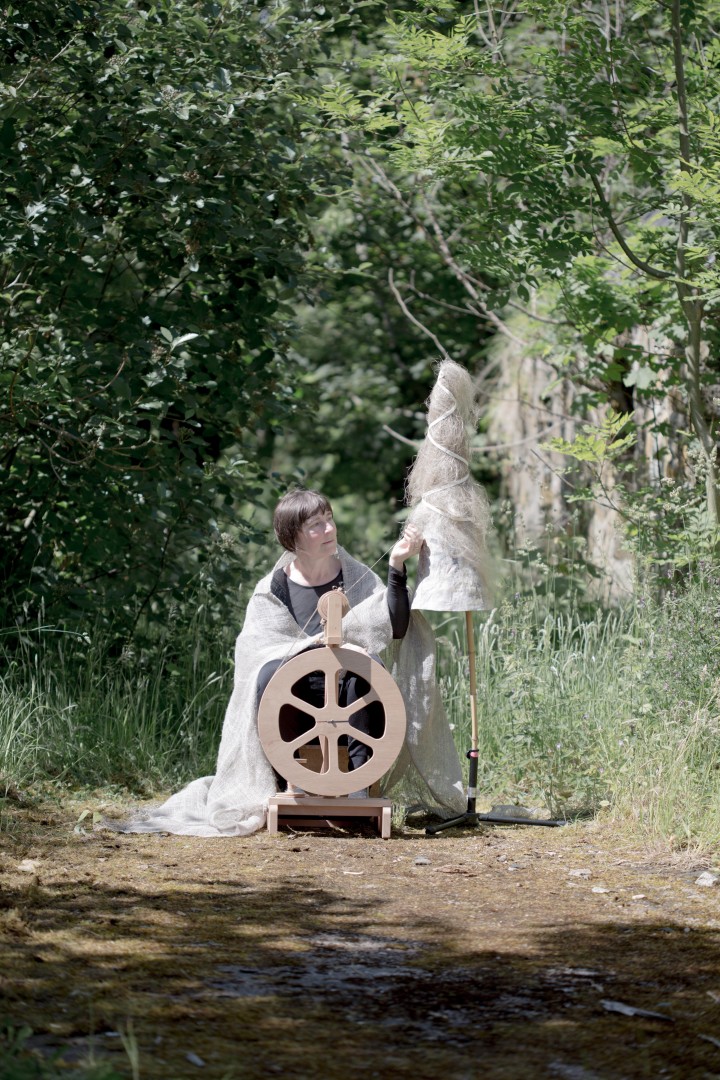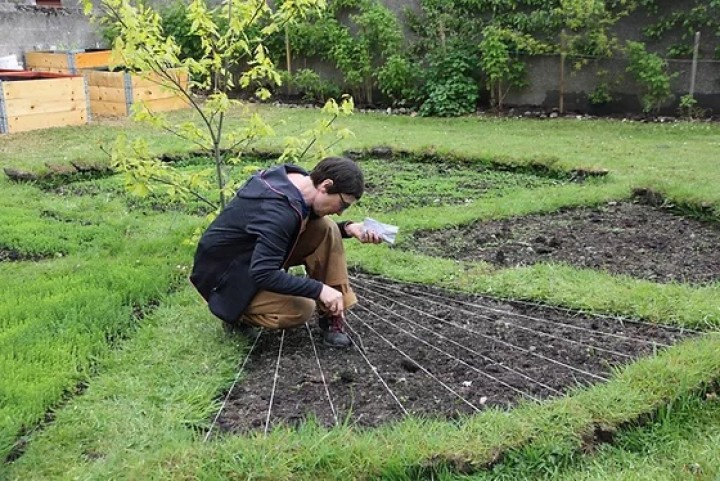Scottish Art News
Latest news
Magazine
News & Press
Publications
The Flax Sower
By Susan Mansfield, 31.10.2022

Christine Borland’s four-year research project with Deveron Arts explores the history of Huntly’s thriving linen industry. Taking flax as a starting point, Borland weaves connections across communities, geographies and histories. Susan Mansfield meets the artist to find out more.
Christine Borland is trying to talk about four years of working on flax without describing ideas which “take root” or themes which “interweave”. Eventually, she just laughs. “It’s really hard not to say things like 'organically' or 'weaving' or 'unfolding.' Everything’s either a growing metaphor or a textile metaphor!”
To continue in the same vein, one might follow a thread from a former weaving town in the North-east of Scotland to the Royal Botanic Gardens in Edinburgh. It might cross-cross a country under lockdown, loop back in time to the plantations of the West Indies, or even forward into a post-apocalyptic future. Start with flax, it seems, and there are few limits to where you might go.
Borland’s engagement with flax began on a residency with socially engaged arts organisation Deveron Projects in the Aberdeenshire town of Huntly in early 2019. Noticing similarities to her hometown of Darvel in Ayrshire, she realised that Huntly had been a flax-growing town in the 18th century, and set out to investigate that history by learning to grow, harvest, spin and weave flax.
Then the pandemic intervened, which also delayed Borland’s solo show at Inverleith House, In Relation to Linum, which eventually happened in summer 2021. Unable to do the research she had planned at the Botanics, her work became more flax-focussed: she developed an online community of growers around the UK and began a writing collaboration with her daughter, Grace Borland Sinclair.
.jpg) Christine Borland in cloak. Courtesy of the Artist.
Christine Borland in cloak. Courtesy of the Artist.
In autumn 2021, she was back in Huntly, developing the spinning and weaving stages of the project, and in September 2022 hosted a day-long concluding event, Flax Turns Foundation Cloth, at Deveron Projects, during which she wore a cape woven from some of the 4km of thread spun from Huntly-grown flax.
“It was always my hope that we would end up with an actual cloth which we grew, spun and wove together,” she says. “I didn’t think it would take four years, but it is amazing to have it. There is something incredibly mind-blowing about the moment when a material that was a plant gets turned into thread and goes on a journey to become cloth.”
Borland’s practice is research-based, and she is often drawn to history, science, medicine, botany - to hidden processes and stories. For the flax project, the intention was always to be hands-on, learning traditional methods to grow, harvest and spin alongside others in a socially engaged way.
Her interest in learning led to a series of digital films, made using motion-capture technology and CGI, imagining how traditional techniques might be passed on to future civilisations. This subject was also the spark for a written work, ‘The Distaff Dialogues’, a collaboration between Borland and her daughter, Grace, a literature graduate currently doing a PhD on Scottish women writers of speculative fiction and science fiction.
Borland says: “I guess we both wanted to explore the way that we learn, the way knowledge is passed on, and we were very interested to try to explore less structured ways which are more to do with embodied knowledge, experiential knowledge, the ways knowledge might be passed on through stories and folk tales. Particularly in relation to women’s stories, it was about unearthing types of knowledge which aren’t necessarily to the fore.”
 Christine Borland planting flax seeds in 2019. Courtesy the artist.
Christine Borland planting flax seeds in 2019. Courtesy the artist.
Spinning, in particular, fascinated her. “I dedicated a lot of time and energy to learning to do it myself and I enjoyed it hugely,” she says. “Evidence of spinning during a drop spindle - literally a stick with a weight on it - has been found all over the world, going back thousands of years. I was intrigued to try to understand how it could possibly be done because it just looked like magic when I saw anybody doing it. At one point, I mastered it, but oh goodness, it was hard!
“Once you’re good at it, you can do this while you’re tending children, tending fields, walking, talking. It enabled women to be spinners and spinsters and still be part of the daily life of their community.”
However, following the Act of Union in 1707, and the formation of Linen Boards to increase the production of cloth for export, spinning schools were set up to encourage women to adopt the spinning wheel, increasing productivity but curbing freedom. Social history pinpoints this as a significant moment in the changing role and status of women, which continued as the processes later became fully industrialised.
To weave the Huntly-grown flax into cloth, Borland enlisted the help of Aberdeen-based textile artist Lynne Hocking. “There was a moment when I thought: do I have to, do I want to learn to weave? But I felt I could keep my integrity on this project without learning to weave myself. Traditionally, the spinners would have had nothing to do with the making of the finished cloth. But when I observed the weaving, I remembered visiting my dad in a factory setting in Ayrshire where he worked in the lace industry. It felt very personal.”
Weaving the flax broadened out to touch other histories too. Borland discovered that the vast majority of cloth woven in the Huntly area - a coarse linen called osnaberg - was exported to the West Indies and Southern United States where it was used to make clothing for slaves. At the Huntly event, she welcomed textile historian Dr Sally Tuckett from the University of Glasgow, and artist and activist Annalee Davis, who is exploring the interweaving histories of Scotland and Barbados, into the conversation about this history.
“As with all the other research I’ve done about textile production throughout my career, this very quickly linked to colonialism,” she says. “These are incredibly interesting and important aspects of that heritage that I want to bring to the fore as part of all this. I reflect with pride on my industrial heritage, and yet we must acknowledge that these stories are part of that, and look at how we can build them into the story and acknowledge them.”
She talks about the finished linen cloth as “an end point and a starting point”. There are other directions the project could take, ideas still on the drawing board, opportunities to present new iterations or make new work. Her business with flax isn’t finished. The thread continues spooling out.
You can read more about Christine Borland’s research project at Deveron Projects, Patricia Fleming Gallery and the artist's website.




